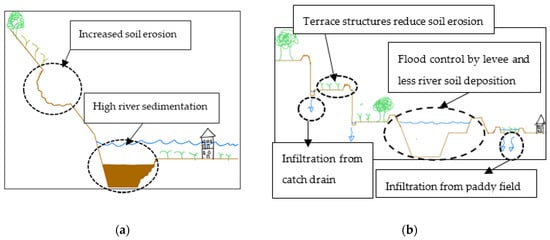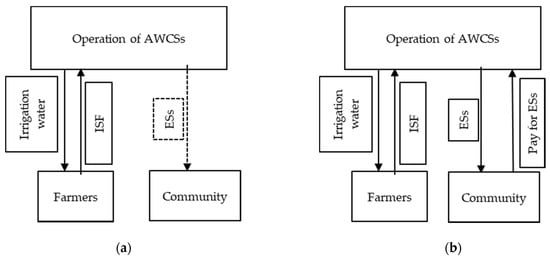You're using an outdated browser. Please upgrade to a modern browser for the best experience.
Please note this is a comparison between Version 1 by Keigo Noda and Version 2 by Catherine Yang.
The Payment for Ecosystem Services (PES) concept was introduced to finance the drives that contribute to the flow of ESs. According to UNDP, in PES, the user or beneficiary of an Ecosystem Services (ESs) makes a direct or indirect payment to the provider of that service. Here, a program is set up where monetary value is created for ESs stemming from land management practices.
- ecosystem service
- payment for ecosystem service
- irrigation and drainage
- infrastructure
1. Introduction
As far back as the 18th century, utility companies in Japan offered grants to upstream forestry workers for their silvicultural activities [1][4]. Payment for Ecosystem Services (PES) were first introduced in the mid-1990s and have proven to be an effective tool for ecosystem conservation, with over 550 active PES programs globally and over USD (United States Dollar) 36 billion in annual transactions [2][5].
The value of water to society is shored up by hydraulic infrastructure, which serves to store or distribute water, thus creating economic, social and cultural benefits [3][6].
Likewise, in addition to their irrigation and drainage functions, the management and operation of agricultural water control structures (AWCS) has been shown to provide other bundles of ESs [4][5][6][7][7,8,9,10] (Figure 1). AWCSs redistribute the river water to the cultivated field and canal network, allowing more time and opportunity for river water to infiltrate into the ground and increase baseflow and aquifer recharge, as well as purifying water and being a refuge for riparian vegetation and organisms. Pre-Inca civilisations were aware of this and built water control structures to divert water to higher elevation areas so as to secure dry season flow in the Andean areas [5][8]. Similarly, in its 2003–2006 8th framework program, the French RMC water agency enacted a new canal contract aimed at taking into account their (canal) multi-functionality [6][9]. Additionally, other bundles of ESs flow from rice paddy growing areas, so-called “multiple functions” of paddy fields [8][9][10][11,12,13]. A well-maintained paddy field, which is a hydraulic structure, modifies hydrologic processes such as peak discharge reduction (flood reduction) and aquifer recharge, provides grain and fibre and maintains a diverse ecosystem.

Figure 1. (a) Mode of flow of materials and ESs in the absence of AWCSs. Increased soil erosion due to steep slope and slope cultivation is highlighted; (b) Mode of modification of the flow of materials and ESs due to the operation of AWCSs. Increased water infiltration to the ground from catch drains and paddy fields as well as reduced flood spatial extent due to levees and reduced soil deposition in the river are highlighted.
Much as a willingness to pay for such ESs was reported by Vivithkeyoonvong et al. [11][14], a UN report revealed the valuation of hydraulic infrastructure and other non-consumptive uses of water as being flawed [3][6]. It is thus remarkable how ESs from AWCSs are not widely considered in agricultural water management strategies.
Globally, ageing infrastructure and the reducing revenues to perform the maintenance and repair of irrigation and drainage infrastructure is a concern [12][15]. Gany et al. recognised the importance of the timely and effective development and maintenance of infrastructure to the secure functionality and sustainability of irrigation and drainage schemes [13][16]. This requires financial resources, which are not readily available. More often, farmers are the sole contributors of fees when they pay a water user fee [14][17], and this is insufficient [15][18]. This water service fee is normally set below its marginal cost or at its sustainability cost to ensure the profitability of irrigated agriculture for farmers [15][18]. Gany et al. attributed the limitation in funding sources to policy ambiguity and the social value associated with irrigation water as opposed to its economic value [13][16]. As a result, in many cases, the burden of major repairs then falls on the central government [15][16][18,19], which is sometimes not forthcoming, given budgetary constraints. Because the charged ISF is meagre, many irrigation and drainage projects then become dilapidated or fail to recover the sunk investment [12][15].
Conversely, rapid urbanisation or the predicted decreasing populations in developed countries lead to the conversion or abandonment of irrigation and drainage infrastructure and areas, respectively [17][18][20,21]. The irrigation and drainage infrastructure should therefore be preserved by highlighting and monetising not only their agriculture production benefit but also their economic and social benefits.
Therefore, alternative sources of income must be explored to complement ISF and ensure the sustainability of irrigation and drainage projects. It is proposed that a PES program be built around the multiple ESs flowing from the operation of AWCSs and the various beneficiaries of these ESs. This will allow the sharing of the cost burden of operation, maintenance and repair of irrigation and drainage infrastructure among the various beneficiaries of the ESs.
2. Challenges Facing PES from the Operation of Irrigation and Drainage Infrastructure
Globally, PES schemes from the operation of irrigation and drainage infrastructure are rare. Tapping this potential and building PES programs around these ESs could be a game-changer in financing the sustainable operation and maintenance of irrigation and drainage schemes. The finance from PES can complement Irrigation Service Fee (ISF) as a source of funds for the sustainable management of irrigation schemes. This could be helpful in areas where the cost of production is very high and prohibitive and in areas where finances to repair, maintain and mange irrigation infrastructure are limited.
Perrot-Maître recognises the challenges of PES schemes because of their success depending on the intersection of scientific, societal, economic, political, institutional and power relationships [19][40]. In areas where this link was strong, such as Japan [20][27] and the USA [21][31], the PES schemes were relatively successful, and future sustainability was guaranteed. Conversely, in areas where the link was weak, e.g., the Uluguru Mountains programme [22][37], with no strong legal backbone to support PES, the long-term success of the scheme was in doubt. In such cases, Perrot-Maître recommended the institution of a strong enforceable contract law.
Many PES schemes are reported to fail after the end of the launch project [22][37]. This could be attributed to the lack of legal or policy framework backing for PES. This claim was supported by de Groot et al. when they reported that the ES concept had yet to be mainstreamed into management and decision making, e.g., in landscape planning or agricultural policy [23][44]. Just like previously mentioned by Perrot-Maître, in such cases, a strong enforceable contract law must be written [19][40].
Numerous PES payments depend on the adoption of suggested management practices and not on the actual measurements of water quality or yield, and it is impossible to determine the contribution of each farm to water quality improvement [24][22][19][28,37,40]. This was the case in all but the FRESPS case study. However, this is not ideal since PES is a trade of ESs. Such ESs must be precisely quantifiable, and it should be possible to attribute a particular environmental management practice to the ES observed. The unique case was the FRESPS case study [21][25][26][31,32,33], where water quality and yield were quantified by a modelling approach, complemented by site measurement of rainfall and water levels to confirm compliance by the ranchers. Less certain was the case study in Kumamoto, Japan, where a scientific study reported rising Lake Ezu water levels and gave the PES program as a possible reason for this occurrence [20][24][27,28].
If setting the price by the valuation of marginal benefits of ESs is impossible, Banerjee and Bark suggested valuation by the opportunity cost to the buyer [27][23]. However, in the Uluguru Mountains case study [28][22][36,37], the opportunity cost to the seller was the basis for the payment. Choosing which opportunity cost to consider could be another point of disagreement, as was seen in the Vittel PES scheme [19][40]—farmers demanded they be paid based on the opportunity cost to the buyer and the buyer insisted they pay based on the opportunity cost to the farmer. Through negotiation, a middle of the road solution that is agreeable to both parties can be reached.
Aggressive farmers knew the value of their farms and wanted to use opportunity cost to the buyer as the level of compensation [19][40]. This was different from the Uluguru Mountain case study, where there were no reports of aggressive negotiations with farmers based on their data. In the Uluguru Mountain case study, which must be the case in many areas where subsistence farming is prevalent, farmer illiteracy and low training meant poor record-keeping and book-keeping on-farm activities. This means there is inequality in negotiating PES deals, especially with big corporations.
3. Further Needs for PES for AWCSs
To be able to estimate the marginal flow of bundles of ESs from PES land management programs, the measurement and monitoring of water resources parameters is crucial. The FRESPS program achieved this [21][25][26][31,32,33]. However, this can significantly increase the cost of PES programs. Therefore, the role of freely available and remotely sensed data and modelling strategies should be explored to fill this gap. These are opportunities for hydrologists to engage in PES schemes. This issue was discussed in previous studies that focused on the challenges and opportunities of hydrological monitoring and modelling (HMM) in the water-related ES assessment of PES schemes [29][30][45,46]. The combined role of HMM should be explored, including improving monitoring networks and improving the salience and credibility of water resources models. Considering budgetary constraints, an optimum monitoring-modelling strategy should be adopted, cognisant of the constraints of each individual strategy. This offers new areas of research.
There is a need for further research in understanding the links between adopted management practices and their marginal contribution to the flow of ESs. If such links are clarified, this can complement or even replace HMM strategies where they are not developed.
4. Recommendations in PES for the Operation of Irrigation Water Management Infrastructure
PES is currently an environmental policy instrument [2][5], e.g., up until now, PES considered green infrastructure such as upstream forest management to preserve /improve water quantity and quality. Developing PES schemes for the operation of irrigation and drainage infrastructure as a complementary finance mechanism for operation, maintenance and repair (Figure 2).


Figure 2. (a) Schematic of the existing financing mechanism for AWCSs. Here, only the direct beneficiaries of irrigation water service pay for the service, while the community indirectly receives free ESs, sometimes even unaware of their very existence; (b) Schematic of a traditional financing mechanism coupled with a PES financing mechanism for AWCSs. Here, the indirect beneficiaries pay for the ESs flowing from the operation of AWCSs, complementing ISF.
In Figure 2, to transition from (a) to (b), ESs flows should be measured and valued so that the potential buyer and seller can be aware of their existence and benefits, enabling smooth and transparent PES transactions. Our research group then took on the task “to develop a coupled hydrological-sedimentation model for sustainable water resources management of small to midsized catchments in Eastern Uganda”.
To ensure better estimates of the number of ESs, a monitoring network coupled with easy and accurate models is useful [21][31]. Ideally, the contribution of each farm to water quality and/or yield should be measured. However, having an observation and monitoring network adds to the cost of the PES program. In addition, the monitoring methods might not be able to precisely quantify ESs from a management practice or even precisely identify the exact contributor of the ES. Therefore, the role of hydrological and water quality modelling should be explored.
To ensure their sustainability, PES schemes should be appropriate to the socio-economic condition and ability of the stakeholders. It would be most ideal to have a smooth transition without the need for massive training, whenever possible.
